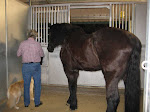We had a family/friends get together and naturally wound up out with the horses. It is usually that way at our place.
Most of the people at our summer BBQ were experienced animal people and some were experienced with horses. We saddled my daughter’s horse, a twentysome-year-old Thoroughbred mare, and let anyone who wanted to ride. Foxy was a great horse. I didn’t get her until she was eighteen, but for the next ten years she took care of my daughter and students while teaching them good horse etiquette.
While she was giving rides Doc, my black stallion (now a long time gelding) was hanging with the people. He likes people, but he is also an alpha horse and any human, horse or other animal that comes within his reach is going to be tested. Most of the people instinctively (read—were well trained) knew to not give him an inch of ground. One man, the new husband of a horsewoman, didn’t know anything about horses.
Doc homed in on the man and when he got too close the man would move. It didn’t take long for the rest of us to notice what was going on. We all watched in unholy amusement as Doc herded the guy all around the group. When the man noticed us smiling, snickering and some (the kids of course) laughing outright he demanded to know what was so funny.
I finally explained to him that one way a dominant horse will exercise its will on another horse is by making the other horse move. Then the higher ranked horse will stand where the lower ranked horse was standing. Doc was training him to be an obedient herd member. Since the man was a fairly successful business executive this information came as an unpleasant shock. He was used to being the alpha and the notion that a horse had dominated him so quickly and effortlessly was not easy to accept.
It is easy to see this type of horse behavior in action at any place there is a gathering of horses and people. If you watch you will see people standing, holding their horse, talking to another person and, when the horse moves too close, they will move and let the horse stand where they were standing. The horse is convinced it is the dominant one of the pair.
Tip For The Day
The Lazy Trainer’s secret here is this--anyone dealing with horses should train themselves to never move when a horse begins encroaching on their territory. It is important to train yourself to always respond to a horse that is trying to move in on you by making the horse move and standing in its territory. At first it takes time and alertness to teach yourself this, but by making the effort consciously, all the time, you will eventually reach a point where your automatic response to a horse trying to move into your space will be to move the horse over and stand where it was standing.
Incidentally, this technique of occupying territory and claiming it also works with dogs. It isn’t always possible to transfer training methods from horses to dogs or dogs to horses because one is a predator and the other is prey. This means sometimes they have opposite reactions to stimuli. In the case of occupying territory though, both horses and dogs are inclined to regard this as a test of who is dominant within the group.
How much effort should you expend doing this? As much as it takes. How much is this? Well in my next blog I’ll tell you how much energy it took to convince a mare that’d been alpha to humans for a decade to move her feet and let me stand in her spot.
Subscribe to:
Post Comments (Atom)










1 comment:
Great story. I've added a recommend link.
Post a Comment